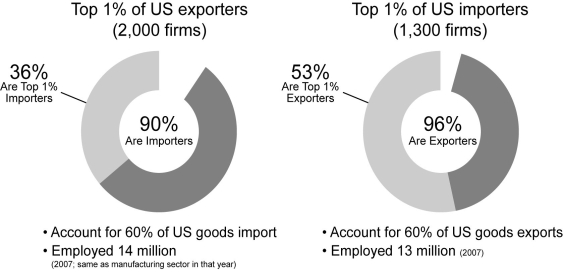Scenario: You learned in the textbook that protectionism via an imposed tariff is not free, since it interferes with market equilibrium and leads to a loss of social surplus in that market. A rationale for imposing a tariff is to shield domestic firms in a particular industry from foreign competition. But what if domestic firms that export goods and services rely on imported inputs in their production? The pie charts below shows that most U.S. exporters are also importers and vice versa.

(Source: J. Bradford Jensen, Importers are Exporters: Tariffs Would Hurt Our Most Competitive Firms, Trade and Investment Policy Watch, Peterson Institute of International Economics, December 7, 2016, https://piie.com/blogs/trade-investment-policy-watch/importers-are-exporters-tariffs-would-hurt-our-most-competitive.)
-Refer to the scenario above.Which statement is consistent with the graphic above?
A) It is not possible to discourage only imports without discouraging exports at the same time in the United States.
B) Tariffs can be an effective tool to promote U.S. exports.
C) Most U.S. importers use domestically produced inputs.
D) Loss of social surplus due to a tariff in one market could be offset by an increase in social surplus in other markets.
Correct Answer:
Verified
Q222: Scenario: The following figure shows the demand
Q223: Scenario: The following figure shows the demand
Q224: Scenario: The following figure shows the demand
Q225: The use of government regulations and barriers
Q226: Scenario: The following figure shows the demand
Q228: The term "infant industries" often refers to
Q229: Scenario: The following figure shows the demand
Q230: Taxes levied on goods and services transported
Q231: What are the infant industry arguments against
Q232: Protectionism leads to _.
A) subsidization of imports
B)
Unlock this Answer For Free Now!
View this answer and more for free by performing one of the following actions

Scan the QR code to install the App and get 2 free unlocks

Unlock quizzes for free by uploading documents